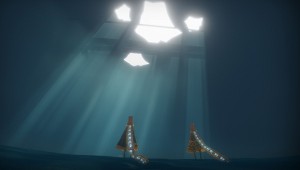A lone traveller stands wrapped within a simple brown cloak, gazing out at a vast desert stretching as far as the eye can see. The harsh sun makes the rolling hills of sand glitter like water on a summer’s day. Only, there is no water here, only the scattered ruins of a long-lost civilization and, in the distance, a towering mountain split down the center. What choice does the traveller have but to move across the shifting sands towards that distant monument?
Journey, more than a game, is an experience. It throws to the wayside the strong-willed invdividual on a quest for self-fulfillment. It scoffs at the epic battles between good and evil and the end of the world. Instead, thatgamecompany thrusts players into a sparse world with no instruction save “x” to jump and “o” to let out the most musical of cries. And so the nameless, faceless traveller begins his exodus across the desert, drawn to each landmark as an escape from the emptiness of his surroundings, slowly unearthing clues about what might have happened to what must have once been a remarkable civilizaiton.
This is a game that strives to push the world of video games into the realm of high art. It does not impress its players with extravagant voice-acting nor does it drag them through hours of tutorials and flashy cinematics. Instead, thatgamecompany banks on the simplicity of awe-inspiring environments where players are left to explore, to feel dwarfed by their surroundings, and to slowly piece together a story by drawing conclusions from the clues planted within the game. There is no narrator to direct the path. There is no plot save the one created by the players and pieced together through a series of images remiscent of ancient wall paintings.
Players interact with the world around them by collecting fragments of ribbons. These ribbons allow to traveller to dance upon the winds– to feel, if only for a few moments, empowered. As he traverses the landscape, the traveller is able to collect various ‘power-ups’ which make the tail upon his cloak longer and allow him a few more seconds of flight. Through this ability to fly he must solve various puzzles to open the pathway toward the distant, towering shadow of the mountain. The puzzles themselves are not particularly difficult, in fact, they can hardly be called puzzles at all. They add a cursory challenge to the game, but players will not find themselves stuck for hours upon a single challenge.
Journey’s unique approach to online-play is, by far, its most powerful mechanic. As a general rule, I like to play my games alone. I saw my first fellow traveller and I turned away from him, racing farther into the desert, further into my forced isolation. Later, I found myself alone within a dark ruin and in the distance I saw the soft glow of a song, a beacon within the darkness. We traversed the caves together. I watched in helpless horror as my companion was attacked by a remnant of a long-lost civilization, as her ribbon was torn and she was thrown to the wayside. I rushed to her side. We could not speak, but we shared that silent moment, vowed to travel to the top of the mountain together. And near the end we huddled together behind a stone, frozen by the icy winds, sharing in warmth and shelter. This is the most powerful interactive experience I have ever had within a game. Strip away the voice-chat and rob players of their keyboards, the knowledge alone that the other traveller upon the screen is a person sharing the same experience is enough.
Journey’s graphics are remiscent of a watercolor painting. A desert world is brought to life, each grain of sand reflecting the sun, vivid red ribbons with blazing gold characters dance across the screen. An environment normally considered a wasteland is brought to life through towering ruins, intense blue-green skies, and the subtle details of the traveller’s cloak blown within the wind. Beautiful simplicity is the name of the game, and at times the sparse landscape of Journey is more stunning than the lush, colorful landscapes of other games.
The soundtrack swells and ebbs with the landscape, creates suspense and soothes anxieties in turn. The crunch of the cloaked hero’s feet the only sound that penetrates the silence. His voice is a series of musical notes; notes that he uses to awaken the magic sleeping within the world around him.
All in all, thatgamecompany’s latest release is an immersive experience that proves not all stories need to be told in words.


